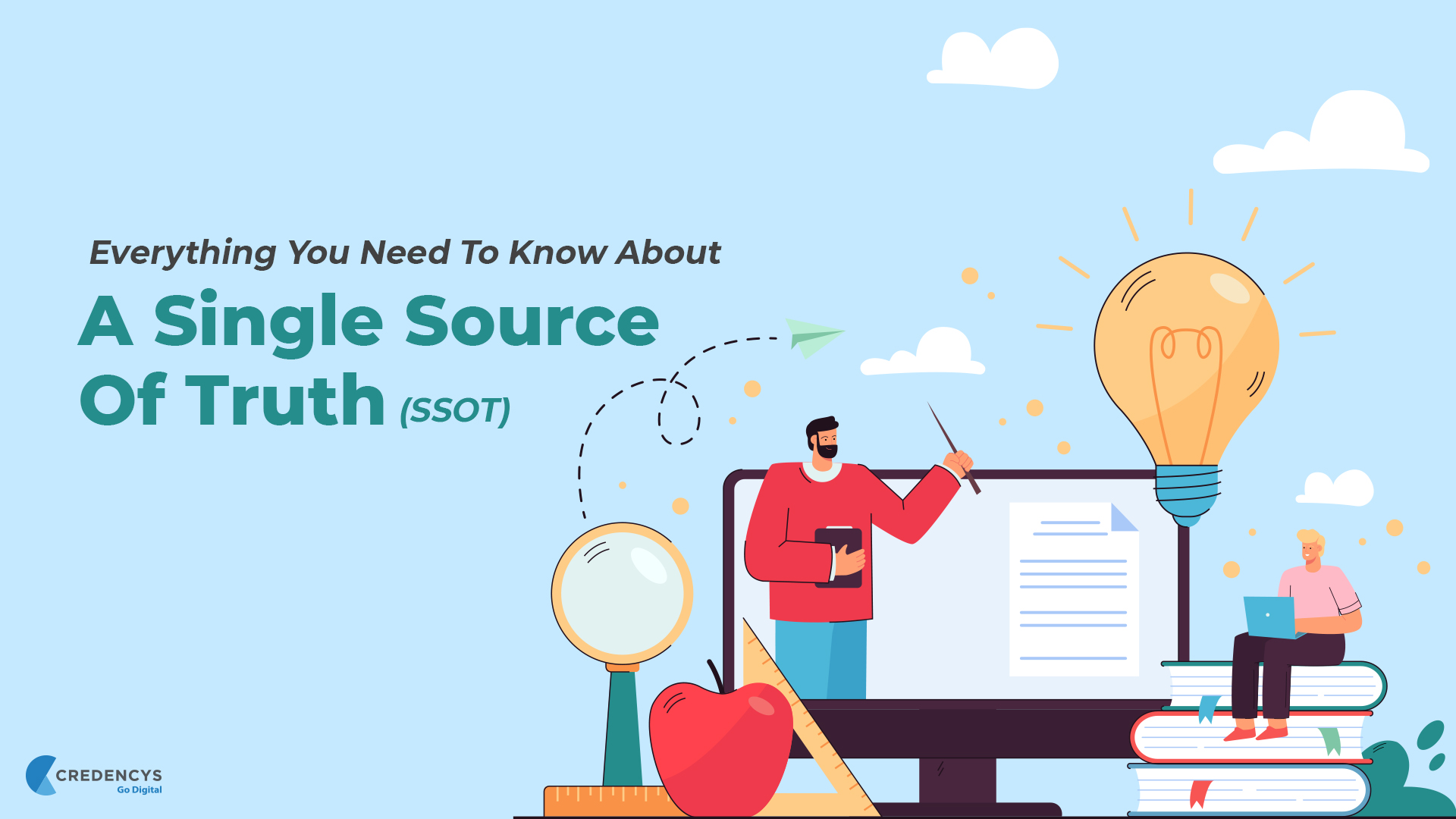A Single Source Of Truth (SSOT) is the way of structuring information models and related data schema such that each data element is edited or mastered in only one place. In modern enterprise settings, deployment of SSOT architecture is very important in our time to avoid risk for retrieval of outdated and incorrect information caused by de-normalized or duplicate data elements.
- What is the Single Source of Truth (SSOT)? How does it work?
- Why is SSOT? Importance & Its Benefits
- How to Create a Single Source of Truth?
- Obstacles of SSOT – How To Overcome?
- Importance of Single source of truth For Retailers
- Importance of Single Source of Truth for Marketers
- How to Improve a Company’s Performance Through a Single Source of Truth?
- Conclusion
What is the Single Source of Truth (SSOT)? How does it work?
A product information management system acts as a single source of truth for every type of product data. Every user of this system maintains such data from one location. You can easily form the product data in any way as per your wishes to let it appear in diverse sales and advertising channels of the company.
A single source of truth is a model intended for ensuring that each one in the business bases informed business decisions on the same data. Companies have to provide relevant personnel with one source for the storage of data points they need when they are ready to put an SSOT in place.
The four supporting architectures used for implementing the single source of truth are enterprise service bus, master data management, data warehouse, and service-oriented architecture. You can focus on different aspects of SSOT and make an informed decision to use it as per your requirements. You will get exceptional benefits from the proper use of the SSOT.
Why is SSOT? Importance & Its Benefits
Creating an SSOT is vital for businesses operating as per the standardized and relevant data across the organization. As a beginner to the SSOT, you can focus on different aspects of this concept and make an informed decision to promote the business.
The best business intelligence and a robust data infrastructure that runs on a single source of truth can eliminate the duplicate data entries, provide the right data for decision-makers at the right time, substantially reduce the overall time spent for identifying which recorded data are correct, and iteratively enhance the company’s data intelligence capabilities.
How to Create a Single Source of Truth?
There are six steps involved in the process of the creation of a single source of truth. The following details explain such steps.
1. Identify data requirements
Many organizations learn to find the data requirements at this time. They have to know how the overall data can be accessed and used by different applications. They must be able to find, define, and describe the entire data elements they require and must include techniques for cleaning, formatting, and standardizing such elements.
2. Data analysis
Data analysis is helpful to businesses to find and map data sources and identify domain standards. It also maps the source data elements to their targets and finds how the overall data can be represented.
3. Integration design
Interior design helps a lot to pull data from different sources. It is more than data retrieval and useful to match and merge various processes. It makes decisions as per the data collected. It helps design the complete extraction and transformation processes for gathering valuable customer insights.
4. Integration development
Integration development is all about how to extract and transform the data. It implements the logic designed in the design stage where the single source of truth development takes place.
5. Verify & validate
If the organization stage is complete, then you have to verify whether the data conforms and adheres to the reception and qualifications criteria. It confirms the incoming data and lets every user verify the solution before implementation.
6. Deploy a solution
If the complete requirements are verified and validated, then the deployment of the single source of truth makes the overall data available for the enterprises to use by the customer data extraction and linking it to the application. You can focus on how to properly use the single source of truth and enhance various aspects of your business. You will get remarkable benefits from an SSOT.
Obstacles of SSOT – How To Overcome?
There are so many obstacles to SSOT. However, the main obstacles are getting participant buy-in, collecting first-class data, knowing what the data tell you as opposed to looking at what the data itself tells you. You can achieve the buy-in by working with senior business leaders to successfully establish which source of information is the best to use. Keep in mind that consensus can be achieved after a discussion and vote.
If you have done it, then you can get high-quality data to such a source by excluding some categories of data like the random data points from executive presentations, allowing data extracted from the official company dashboard, and filtering & storing the overall SSOT data to one platform accessible by everyone across the company.
There is a fine line between what data is about and what it says. You can enhance your business when you make your business platform online responsive and refine the messaging needs of the company further.
Importance of Single source of truth For Retailers
Retailers wish to do everything to attain the strongest competitive advantage in the modern retail landscape. They keep in mind that the shopping habits of consumers keep evolving and try to do different things to fulfill their expectations. They use their customer and product data to succeed in the new retail landscape.
Business retailers are able to create a seamless and unified commerce customer experience with the help of the gathered business data. This view refines customization for maximum sales and optimizes the business operations for the highest possible efficiency. These enhancements are easy to implement and scale when the business develops as all this information is consolidated into one system.
1. A unified customer experience across every channel
Smart and experienced retailers provide omnichannel experiences meant to be seamless. These unified commerce experiences usually have gaps frustrating customers. Creating a unified commerce experience is difficult for some retailers as to how each channel evolved independently over time with different technologies, systems, and databases.
The best solution to this problem is to bring the overall data to be orchestrated into the same place accessible by each channel in real-time that is a single source of truth with unified data for creating experiences consistent with shopping history, channels, location, preferences, and other things associated with each customer.
2. Enhanced customization for strong customer relationship
Unification of customer data makes a one-stop-view of the overall shopping and browsing activities. The complete marketing messages can factor in the modern activities across every channel and touchpoint. Timely and accurate customization is vital for a very good shopping experience and building trust with all customers and making marketing messages they welcome.
3. Optimized operations for cost and time savings
Retailers who access the logistics, inventory, sales, and fulfillment data in one location can plan their inventory, enhance order management, and streamline logistics.
Importance of Single Source of Truth for Marketers
One source of truth in place for the marketing data is vital for customization, customer segmentation, competitive analysis, cross-selling & up-selling, return on marketing investment, and employee productivity.
1. Customization
Customized interactions result in high response rates from all customers. Companies have to look at the complete records to find each customer to have customized interactions with them. These things include personalized written and oral communication.
2. Customer segmentation
The marketing team has to group customers based on the value they provide to the business. Teams can work with a limited set of customers by grouping customers into segments and letting them provide a customized experience for producing a very good result. Segmenting customers is possible by understanding the preferences and behaviors of customers.
3. Competitive analysis
A single source of truth lets you better understand how your competitors deal with customers. It helps a lot to find chances that they miss and optimize tactics based on the customer.
4. Cross-selling & up-selling
You can design target products based on customer purchases. You must have a central data repository that keeps track of purchase histories and also transactions.
5. Return on marketing investment
The marketing team can analyze and understand the preferences of customers by having a single source of truth. This team has to understand the patterns and behaviors of customers. It can effectively market products.
6. Employee productivity
An organization with a single source of truth can spend less time researching and gathering data. It can spend maximum time on the analysis of the data to gain important customer insights.
The main challenges in unifying marketing data are poor data quality, missing metadata, data availability, and data development framework. Crystal clear details about a single source of truth and its benefits for marketers give you an overview about how to properly use it and enhance the business further.
How to Improve a Company’s Performance Through a Single Source of Truth?
Everyone in the business sector has to enhance their efforts to find which data they have to focus on at first as they have different sets of data and make business-informed decisions on time. It is the appropriate time to know how to align the overall company on a single source of truth to enhance performance.
1. Create a multi-department data team
Every team in the company has to keep and use high-quality data to succeed in their everyday work. They can enhance their performance when they get a representative from operations, sales, customer success, product, marketing, finance, and other associated departments.
Drawing all professionals from each department lets them find and understand what is going on in any other department. They can use this knowledge and agree on associated objectives they have to pursue enhancing the experience of every customer at every stage of the journey.
2. Marketing and sales leaders have to agree on the top KPIs
If you make a data team, then you can use a calendar tool and schedule a multi-department team meeting that fits the schedule of everyone. You have to agree on the KPIs that you have to track.
The process-based and outcome-based KPIs give you a clear view of the actions contributing to a particular result. You have to start aligning data to a single source of truth by making KPIs in any department like finance, human resources, marketing, and customer service.
3. Implement tools and dashboards
If you have agreed on the KPIs, you have to track, select a system that integrates with any other tool you use like Google Analytics, Google PPC ads, and CRM software. You must create initial dashboards and visualizations to give everyone details about how various marketing initiatives perform.
The most important data feed into the dashboard has to be quality of service, performance, and productivity. The quality of service impacts the service on customers via the reviews they get and their customer retention rate. The performance is the amount of time it takes to solve the issues of customers. Productivity is all about how much work every customer service representative does.
The data you enter must be consistent and accurate to assist you to find areas where you have to enhance and deliver very good customer experiences. Your dashboard has to be easy to use so that it improves complete productivity by reducing the time it takes to access data and get actionable insights from it.
4. Meet regularly with the data team and make data-driven decisions
Qualified marketing teams defend the decisions they make when it comes to the effective strategies they apply to attract new clients. They use the dashboard to justify the paid acquisition strategies.
Conclusion
Every user of a Single Source of Truth enhances their business in different aspects within a short period. They make certain concrete gains they attain from an SSOT. They make informed decisions to enhance their product development, manufacturing, procurement, marketing, after-market services, sales, and other categories of business development activities. They are confident and happy to recommend SSOT based business development strategies for like-minded business people worldwide.








Tags: